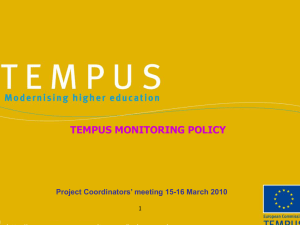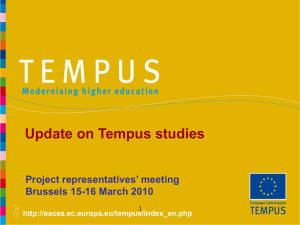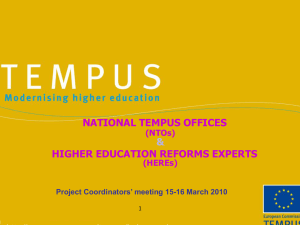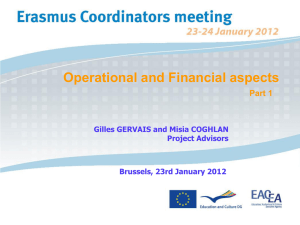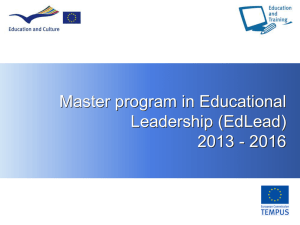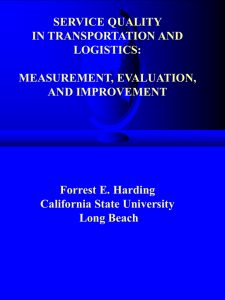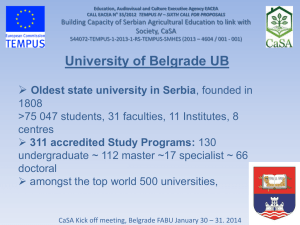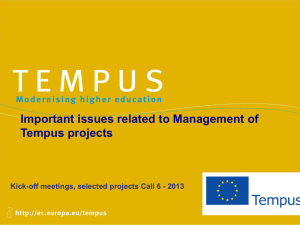Final Report - EACEA
advertisement
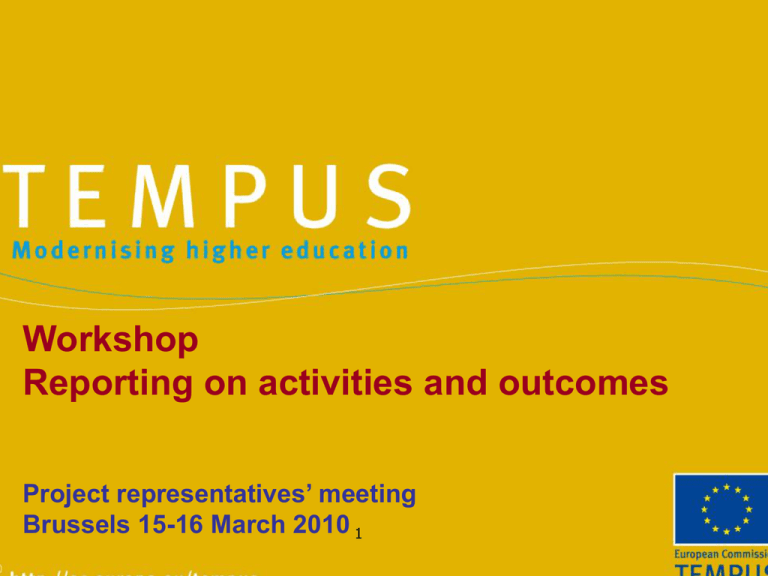
Workshop Reporting on activities and outcomes Project representatives’ meeting Brussels 15-16 March 2010 1 Outline of the presentation I- Submission of the reports II- Structure of the reports Description of the project’s progress Statistics & Indicators Table of Achieved/Planned outcomes Summary report for publication Statement on the costs incurred/Financial statement III- Modifications during the project implementation I- Submission of the reports Submission of the reports When? Intermediate Report When 70% of the 1st pre-financing has been disbursed and not later than half way through the eligibility period: • • 2 year projects (15/01/2010-15/01/2012) 15/01/2011 3 year projects (15/01/2010-15/01/2013) 15/07/2011 Final Report 2 months after the end of the eligibility period: • • 2 year projects (15/01/2010-15/01/2012) 15/03/2012 3 year projects (15/01/2010-15/01/2013) 15/03/2013 Submission of the reports Please note that the timely submission of the reports is a contractual obligation. Any delay in reporting may have an impact on the monitoring of the project. If you cannot meet the deadlines, please inform the Education, Audiovisual and Culture Executive Agency in writing immediately. An extension of the deadline for the submission of the reports can exceptionally be granted if duly justified and requested well in advance. Submission of the reports The Intermediate and the Final Reports are submitted as a paper copy using the forms available on the Tempus website Three copies of which one original to be sent by the deadline with registered mail (date as per postmark) to: Mr Klaus Haupt Head of Unit Education, Audiovisual & Culture Executive Agency (EACEA) Tempus Unit/P10 BOUR 2/19 B-1049 Brussels An electronic version to be sent to: eacea-tempus-project-management@ec.europa.eu What do I need to send? Intermediate Report: 1 original/ 2 copies Report on implementation of the project (including Statistics& Indicators, Table of achieved/planned outcomes, Summary report for publication) Statement of the costs incurred and Request for Payment Final Report: 1 original/ 2 copies Report on implementation of the project (including Statistics& Indicators, Table of achieved/planned outcomes, Summary report for publication) Financial statement including the Request for payment and the financial tables for each budget heading External audit report on the action’s financial statements and underlying accounts (required if the Tempus grant as shown in Annex II of the Grant Agreement is equal or greater than EUR 750,000) Submission of the reports Why two reports? Intermediate Report: Progress in relation to activities Final Report: Overall achievement level in relation to the total awarded grant and details on all expenses NOTE: The reports can be either accepted/rejected If rejected: Need to submit a new version Rejection linked to the non compliance with the reporting requirements, not to the implementation of the project itself. II-Structure of the reports Intermediate and Final Reports Report on implementation of the project Statistics and indicators Table of Achieved/Planned Outcomes Summary report for publication Report on implementation of the project Intermediate Report Overall achievement Coherence with the workplan and comments on deviations and modifications Obstacles and shortcomings Development of programmes and courses Restructuring: university management and governance Staff (re-)training Report on implementation of the project Intermediate Report Staff mobility Student mobility Academic coordination and administrative management Equipment Dissemination Sustainability Quality control and monitoring Gender balance Any other comment Report on implementation of the project Final Report Part I Activities carried out Short description of the activities carried out since the submission of the Intermediate Report Describe the main changes that have occurred in the plans described in the IR. Development of programmes and courses Restructuring: university management and governance Mobility and training activities for staff and students Equipment Dissemination and Sustainability Report on implementation of the project Final Report Part II Project outcomes and Impact Overall achievement level and impact Obstacles and shortcomings Curricular reform Governance reform Links with society Mobility and training activities for staff and students Equipment Academic and administrative management Dissemination and Sustainability Unexpected outcomes Gender balance Statistics and Indicators To gather statistical data and indicators of performance for the period covered by the Intermediate Report or the entire project duration Main targets: Teacher training Vocational Education and Training Qualification levels addressed by the project Training and mobilities: Training of partner country staff Staff mobility Student mobility Links to European Higher Education policies Table of Achieved/Planned Outcomes Aim: to provide the achievements of the project in relation to the original proposal The report contains one table for each outcome identified in the project proposal: 1. Activities carried out and indicators of achievement 2. Planned activities and indicators for progress 3. Any proposed changes Table of Achieved/Planned Outcomes Example Description of the project’s progress: some tips Identify questions that are relevant to your project Build upon the information provided in previous report (applicable to the Final Report) Don’t hesitate to report any shortcomings Don’t hesitate to give us background information Be as detailed as possible, demonstrating progress with indicators Description of the project’s progress: some tips What do we mean by indicators? They are the “sign-posts” used to measure the performance of the project throughout its lifecycle. They provide a basis for the monitoring of the project’s progress and should therefore be considered as an ongoing evaluation mechanism within the project. Indicators should be specific in terms of quantity, quality, time and target group. Description of the project’s progress: some tips Some examples of “Tempus” indicators: “Staff trained” 5 of the 10 staff members of the Department have acquired new skills which have been evaluated and certified by the Project Board in January 2010. “Centre established” Centre formally established through Statute dated 1 September 2010 as a Unit of the Faculty, with 2 staff members, equipment, 3 classrooms and additional Faculty financial resources until 2015. “Student mobility achieved” 3 undergraduate students in their final year acquire in July 2009 20 ECTS following a 3-month study period in the EU during Spring 2009. Description of the project’s progress: some tips Dissemination Describe what has been done to disseminate the results of the activities carried out, both within the framework of the project and outside the project. Indicate: the type of activities and the dissemination channels used to make the project results available to larger beneficiary groups. If there have been any unexpected positive secondary effects from project activities, please describe them in this section. Description of the project’s progress: some tips Examples of dissemination activities Set up a project website (indicate the link) Brochures, newsletters of the partners Organisation of workshops, seminars, final conference Information in the newspapers Description of the project’s progress: some tips Sustainability How did you achieve a multiplier effect of the project? Do you think that the successes will go beyond the immediate target group? Do you think that the beneficiaries (institutions) will be able to sustain and develop the achievements of the project? Do you foresee any future co-operation between the beneficiaries of your project? How do you plan to use the results of the project in the future? What measures have been taken to formalise or institutionalise links with local non-university partners? Description of the project’s progress: some tips Examples of Sustainability Accreditation of the new curriculum Memorandum of understanding between the project partners to continue the collaboration after the end of the project Agreements with other stakeholders Summary Report for Publication Aim: To provide the EACEA with the main information about the project, the progress, any problems, next steps and any other remarks in a format that can be published Statement on the costs incurred and Request for payment Intermediate Report To provide the EACEA with an overview of the project expenses and the co-financing situation together with the state-of-play of project activities. Intermediate Report Example of Statement of costs incurred and Request for payment Financial statement Final Report Financial statement: To provide the EACEA with the final statement on all expenditure incurred in the framework of the project. Fill the accompanying financial tables in the Financial statement excel file published on the website Fill each of the 9 different excel worksheets For each budget heading: you must declare all expenditure incurred by the project during the eligibility period, both paid by Tempus and co-financed. NOTE: Request for payment of the balance (Annex 13) Financial statement Final Report Supporting documents for expenditure Only for: Equipment if the costs exceeds EUR 25.000 (invoices) Sub-contracts if the costs exceeds EUR 25.000 (conventions/contracts and invoices) Financial statement Final Report External audit report on the action’s financial statements and underlying accounts Required if the Tempus grant as shown in Annex II of the Grant Agreement is equal or greater than EUR 750,000. Cost of the external audit report can be charged under “Other costs”. Final Report Example of Financial Statement Reports & Payment Cycle Payment of 1st pre-financing: 60% of the amount specified at I.4.3 of the Grant Agreement within 45 days of: - the date when the last of the parties signs the GA - upon receipt of a financial guarantee if required in Annex I INTERMEDIATE REPORT: when 70% of the first pre-financing has been disbursed and not later than half-way through the eligibility period - report on the action’s implementation (IR) - summary report for publication - statement on the costs actually incurred and request for payment of the 2nd prefinancing (30% of the amount specified at I.4.3 of GA) when 70% of the 1st pre-financing has been disbursed) Payment representing the 30% of the amount specified at I.4.3 of GA within 45 days following reception of request for payment FINAL REPORT - 2 months after the end of the eligibility period - final report on the action’s implementation (FR) - summary report for publication - financial statement and supporting documents Payment representing the balance of the grant within 45 days following approval of FR III- Modifications during the project implementation Modifications Prior written request to the EACEA for authorisation is needed for: Addition of a consortium member Withdrawal of a consortium member Changes of contact person at the coordinator/co-beneficiary Modification of project’s activities Modification of the budget Extension of the eligibility period NOTE: Some modifications lead to an Amendment to the Grant Agreement Modifications: general advice Modifications in terms of budget and activities acquire contractual value after prior written approval of the EACEA. Requests for modifications should be duly justified in relation to the project objectives. Modifications should be detailed and asked well in advance. Modifications can be introduced either through the Intermediate Report or through general correspondence. Addition of a consortium member A request should be sent to EACEA: a new partner is eligible for funding only after approval by the EACEA. A new co-beneficiary should be included before the final project year. The request should contain a detailed justification of the reasons why the new co-beneficiary should join. The enlargement will not lead to an increase of the maximum grant amount. Formal requirements: Request by the coordinator A mandate signed between the coordinator and the new cobeneficiary Letters from all the current co-beneficiaries, confirming their agreement to the inclusion of the new institution Withdrawal of a consortium member Procedure 1. The withdrawing institution should send an official letter signed by the legal representative to the coordinator confirming their withdrawal from the project. 2. The coordinator should send written confirmation to EACEA including: a detailed description indicating the consequences on the project’s objective(s), outcomes and activities. the letter from the withdrawing co-beneficiary NOTE: The eligibility criteria of the partnership indicated in the Call for Proposals must always be respected. Change of contact person at the coordinator/ co-beneficiary Procedure Change at the coordinator: Send a written confirmation (letter) signed by: the new contact person the former contact person of the coordinator the legal representative of the coordinator Change at one of the co-beneficiaries: The coordinator should send an email confirmation to EACEA NOTE: The coordinator can be changed but only under the most exceptional circumstances. Modification of the project activities Requests for modifications should be duly justified in relation to the project objectives. The budgetary implications of these changes will also need to be taken into account. Requests for modifications should be detailed (nature and type of activities, overall added value, etc.) Such changes should be introduced either through a prior written request or in an interim report. Requests should be made well in advance. Modification of the budget Budget modification is required when more than 10% of increase of a budget heading. (when less than 10%, no need of prior authorisation) Need to ask a budget modification before the additional costs are incurred. Provide the original budget and the new budget, indicating clearly the transfers done between the budget headings. Extension of the eligibility period Extension of the eligibility period might be granted on an exceptional basis. Delays inherent to the project and in the implementation of the work plan will not be considered sufficient reasons. Only one extension granted for a maximum of 12 months. The extension of the eligibility period will require a formal amendment of the Grant Agreement. The request should be made as soon as possible and, in any case, no later than one month before the end of the eligibility period. General advice for your reporting Schedule the co-ordination meetings in due time Coordinator should be involved in the reporting Provide clear and concise information Do not under-estimate the time and the human resources needed for the reporting activities Collect the supporting documents as soon as activities have taken place Who may help? Frequently Asked Questions on the Tempus website The contact person at the Tempus Unit in EACEA EACEA-Tempus-Project-Management@ec.europa.eu The NTO or the NCP The International Relations office of the University EVE Espace Virtuel d’ Echange/Virtual Platform for information sharing Public electronic platform for the dissemination and exploitation of project results Project coordinators can upload basic information about their project and its results (outputs, pictures, links, presentations) More information: http://www.ec.europa.eu/eve Guide for project promoters More on: http://eacea.ec.europa.eu/tempus 46
